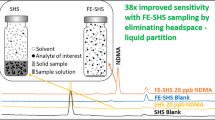Abstract
A method for the simultaneous determination of hydrogen cyanide (HCN) and aliphatic nitriles using manual headspace (HS) gas chromatography (GC) with a capillary porous polymer column GS-Q and a nitrogen–phosphorus detector is described. With a HS incubation at 50°C for 30 min and a GC temperature at 180°C, HCN and volatile nitriles [acetonitrile, acrylonitrile (VCN), propionitrile, isobutyronitrile] were well separated and could be detected within 7 min with a detection limit of 0.7–2.4 ng/ml in blood samples. The HS-GC method was used in an in vivo study of VCN metabolism. VCN was administered orally (at nearly one-half its LD50) to rats, and heart blood and urine were sampled. Blood concentrations of HCN and VCN were measured by HS-GC, and plasma and urinary thiocyanate concentrations were measured by the König colorimetric method. Blood levels of HCN and VCN peaked 1.5 h after VCN administration, at which time the cyanide level (about 0.7 μg/ml) is close to the fatal level. HCN levels were observed to be at almost background levels at 10 h, although 50 ng/ml VCN was still detectable. The plasma thiocyanate level increased, reaching a peak (about 30 μg/ml) at 5 h. The cumulative urinary thiocyanate amount gradually increased, and at 10 h more than 1 mg thiocyanate was excreted into the urine. It is therefore possible to clarify the cause of cyanide poisoning using HS-GC analysis, when someone has taken volatile nitriles.


Similar content being viewed by others
References
Curry SC (1992) Hydrogen cyanide and inorganic cyanide salts. In: Sullivan JB Jr, Krieger GR (eds) Hazardous materials toxicology—Clinical principles of environmental health. Williams & Wilkins, Baltimore, pp 698–710
Fassett DW (1962) Cyanide and nitriles. In: Patty FA (ed) Industrial hygiene and toxicology, 2nd edn, vol 2. Interscience, London, pp 1991–2036
Feierman DE, Cederbaum AI (1989) Role of cytochrome P450 IIE1 and catalase in the oxidation of acetonitrile to cyanide. Chem Res Toxicol 2:359–366
Freeman JJ, Hayes EP (1988) Microsomal metabolism of acetonitrile to cyanide. Biochem Pharmacol 37:1153–1159
Geiger LE, Hogy LL, Guengerich FP (1983) Metabolism of acrylonitrile by isolated hepatocytes. Cancer Res 43:3080–3087
Guengerich FP, Geiger LE, Hogy LL, Wright PL (1981) In vitro metabolism of acrylonitrile to 2-cyanoethylene oxide, reaction with glutathione, and irreversible binding to proteins and nucleic acids. Cancer Res 41:4925–4933
Lundquist P, Kågedal B, Nilsson L (1995) An improved method for determination of thiocyanate in plasma and urine. Eur J Clin Chem Clin Biochem 33:343–349
Michaelis HC, Clements C, Kijewski H, Neurath H, Eggert A (1991) Acetonitrile serum concentration and cyanide blood levels in a case of suicidal oral acetonitrile ingestion. Clin Toxicol 29:447–458
Ohkawa H, Ohkawa R, Yamamoto I, Casida JE (1973) Enzymatic mechanisms and toxicological significance of hydrogen cyanide liberation from various organothiocyanates and organo-nitriles in mice and houseflies. Pest Biochem Physiol 2:95–112
Salkowski AA, Penney DG (1994) Cyanide poisoning in animals and humans: a review. Hum Exp Toxicol 36:455–466
Seto Y (1994) Determination of volatile substances in biological samples by headspace gas chromatography. J Chromatogr A 674:25–62
Seto Y (1995) Oxidative conversion of thiocyanate to cyanide by oxyhemoglobin during acid denaturation. Arch Biochem Biophys 321:245–254
Seto Y (1996) Determination of physiological levels of blood cyanide without interference by thiocyanate. Jpn J Toxicol Environ Health 42:319–325
Seto Y (2002) False cyanide detection. Anal Chem 74:134A–141A
Seto Y, Kataoka M (2001) Dependence of detection sensitivity of volatile substances on physicochemical properties and analytical conditions in headspace gas chromatography. Jpn J Forensic Toxicol 19:218–227
Seto Y, Tsunoda N, Ohta H, Shinohara T (1993) Determination of blood cyanide by headspace gas chromatography with nitrogen-phosphorus detection and using a megabore capillary column. Anal Chim Acta 276:247–259
Silver EH, Kuttab SH, Hassan T, Hassan M (1982) Structural considerations in the metabolism of nitriles to cyanide in vivo. Drug Metab Dispos 10:495–498
Sousa AB, Soto-Blanco B, Guerra JL, Kimura ET, Gorniak SL (2002) Does prolonged oral exposure to cyanide promote hepatotoxicity and neurotoxicity? Toxicology 174:87–95
Streete PJ, Ruprah M, Ramsey JD, Flanagan RJ (1992) Detection and identification of volatile substances by headspace capillary gas chromatography to aid the diagnosis of acute poisoning. Analyst 117:1111–1127
Subramanian U, Ahmed AE (1995) Intestinal toxicity of acrylonitrile: in vitro metabolism by intestinal cytochrome P450 2E1. Toxicol Appl Pharmacol 135:1-8
Swanson JR, Krasselt WG (1994) An acetonitrile-related death. J Forensic Sci 39:271–279
Tanii H, Hashimoto K (1984a) Structure–toxicity relationship of aliphatic nitriles. Toxicol Lett 22:267–272
Tanii H, Hashimoto K (1984b) Studies on the mechanism of acute toxicity of nitriles in mice. Arch Toxicol 55:47–54
Willhite CC, Smith RP (1981) The role of cyanide liberation in the acute toxicity of aliphatic nitriles. Toxicol Appl Pharmacol 59:589–602
Author information
Authors and Affiliations
Corresponding author
Rights and permissions
About this article
Cite this article
Shibata, M., Inoue, K., Yoshimura, Y. et al. Simultaneous determination of hydrogen cyanide and volatile aliphatic nitriles by headspace gas chromatography, and its application to an in vivo study of the metabolism of acrylonitrile in the rat. Arch Toxicol 78, 301–305 (2004). https://doi.org/10.1007/s00204-004-0545-4
Received:
Accepted:
Published:
Issue Date:
DOI: https://doi.org/10.1007/s00204-004-0545-4




